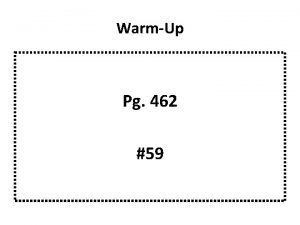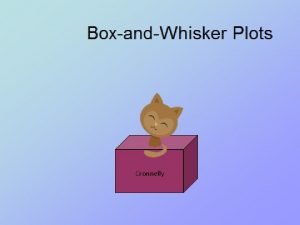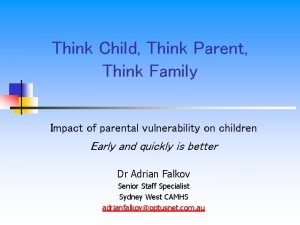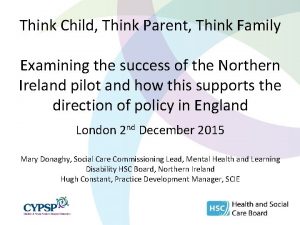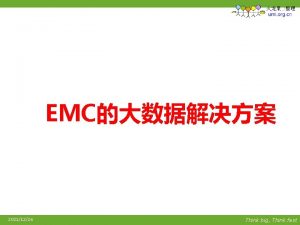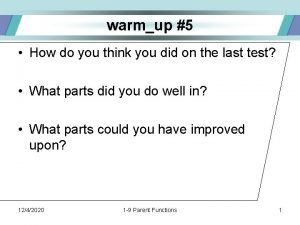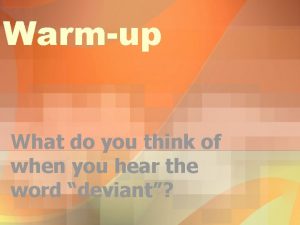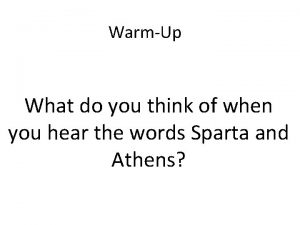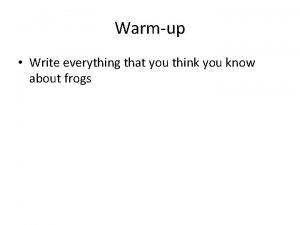WarmUp What do you think of when you













- Slides: 13

Warm-Up What do you think of when you hear the word “renaissance”?

Ch. 17 : The Renaissance and the Reformation Sect. 1 – Italian Renaissance Goals: 1. Explain the conditions in Italy that led to Renaissance. 2. Identify values and ideas of Renaissance 3. Identify key artists, breakthroughs and achievements of the Renaissance. 4. Identify important writers of the time and summarize their work.

Out of the Middle Ages • Rome falls to invading forces in 476 C. E. (or A. D. ) • By that time, the Roman Catholic Church is already a force • The Church will dominate European life for the next 1000 years • Middle Ages sometimes called the “Age of Faith” • Much of the learning and philosophy of the Classical world is lost to Europe

But Things Begin to Change Europe comes in closer contact with what today we would call the Middle East • Constantinople (now Istanbul, in Turkey) • Jerusalem (in today’s Israel) • Alexandria (in Egypt) How? • Increased trade between Europe and Asia (through the Middle East) • biggest factor is the Crusades

The Crusades • Are a series of attempts by Europeans to take back Jerusalem from Muslim control • They largely are failures, but it does get Europeans into the Middle East • Compared to Europe at the time, the culture of the Middle East was more advanced; scientifically and creatively

And Once They are There… • They will once again come in contact with classical works such as • Plato’s philosophy • Aristotle’s philosophy • Cicero’s letters • Pythagorean math • Euclidian geometry • And so on….

This Leads to the Renaissance • Renaissance literally means “rebirth” • It is a word designed to show what happens when classical learning is “reborn” within Europe • Scholars in Europe begin to explore works that hadn’t been seen for centuries • It leads them to look at the world in a new way, and even to challenge the Roman Catholic Church

Renaissance: Why Italy? Time of a rebirth in learning and the arts in Europe between 1300 -1600 A. D. began in Italy the spread across Europe Combination of three conditions made Italy fertile grounds for a rebirth of ideas, art and interest in learning Italy’s Advantages: v City-States: several large urban centers, diverse pop. v Classical Heritage: Connection w/Ancient Greece and Rome, ruins, ancient texts, Latin language v Wealthy Merchants: plague affected economy – laborers and merchants got higher pay/profits

Why Italy? - Merchant Class cont. Smarts + business sense = $$$$ for merchant class Individual achievement not inherited social rank became important Merchants began to seek out power and influence in society and governing of cities Medici- a family of bankers in Florence, Italy that became dictator like rulers due to their financial influence

Classical & Secular Values Medieval Classics = Christian thought + Classical ideas Renaissance = Study of classics led to Humanism- a focus on human achievements and human potential. Humanities = history, literature, art and philosophy Switch from focus on the Church to Secular Values Though most people were still devout Christians. Renaissance was more secular than Middle Ages They believed that one could enjoy life, luxury and fine food w/o offending God

Art Patronage Wealthy Nobles/Merchants and the Church were all important art patrons – members of society who would pay artists to complete public and private works of art Churches would hire artists to paint frescoes, carve sculptures or build architectural features for the cathedrals Nobles/Merchants would hire artists to paint portraits or religious pieces, sculpt public statues or decorate their homes

The “Renaissance Man” Renaissance Man- the idea that a well educated, man should be good in several areas -charming, witty and educated in the classics - able to dance, sing, play music and write poetry -skilled horseman, wrestler and swordsman Renaissance Woman- women should inspire art, not create it, more education than in M. A. , but still not very influential in politics

Renaissance Art Returned to Classical ideas of realistic portrayal of body and space Emphasis on individual differences through portraiture Perspective –use of vanishing points to represent 3 dimensions on a flat surface















